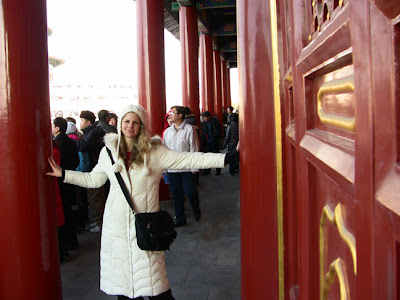The Temple of Heaven is where the Emperor would pray for a good harvest in the days of the Ming and Qing dynasties. There are gorgeous circular buildings and wide rectangular halls in the ancient Chinese style. We were lucky to visit during Cultural Week. Halfway through our wanderings, the inner square was roped off and scores of figures in colorful traditional robes performed a sort-of Tai-Chi with weapons. Awesome. The whole complex is huge. We walked a lot, stopping at sections of interest haphazardly. The Circular Mound Altar was swarming with people behaving as if in a punk concert mosh pit, shoving their way to stand on the altar where the Emperor made a burnt offering to Heaven. Through all the feet, we were at least able to catch fleeting glimpses of the altar.
We passed an outdoor market on the way out, stopping to buy dried kiwi. Back on the streets we realized the metro entrance was at another end of the complex, far away, and there was no way back in, short of paying again. Thankfully we found a bus back to south Tiananmen (Ness recognized the correct characters) and walked the tunnel under the street to the Forbidden City, dodging more “art students” and suited-men demanding we take their travel service to the Wall.
The Forbidden City covers a smaller area than the Temple of Heaven, but it has a lot more buildings – a small city's worth, essentially. This is where Emperors, their households, the entirety of the government lived for five centuries, cut off from the common people. It is a feast for the eyes, every alleyway and enclosed garden felt like walking through another age. Still, it was hard not to think of the enormous gap between the lifestyle of the royal and peasant-class. I had the same thoughts at Versailles years ago– the sheer opulence of that palace is almost suffocating, especially taken in the context of the time. Unlike Versailles, however, the excesses of the Forbidden City are more aesthetically pleasing, with intricate sculpted dragons and painted archways, and not so much gold-plated this, and jewel-encrusted that.
Later that night the city exploded into celebration. Up until now fireworks had been going off daily ever since the start of the New Year, louder and more frequent in Beijing than in Mudanjiang or Harbin. But this night in particular was intense. Searching for a restaurant on the street near our hotel, we dodged explosions left and right. Rockets whizzed passed our heads, sparkling fountains of light sprouted in every direction. It was like moving through a war zone, bright and chaotic and deafening. We later learned it was the 5th night of the New Year festival – the birthday of the Chinese god of wealth. All the fireworks are to get the god's attention, ensuring his favor and good fortune.









3 comments:
It's all so awesome. I think if I were in China, I'd feel like I was walking through a kung fu flick movie set. hehe.
Love the pic of the little girl in Chinese garb. The temples are really amazing! So different from Western Architecture!
next time you're giving to the money god, make a donation in my name pretty please :-)Love the pictures. So fun to see the colors and architecture.
Post a Comment